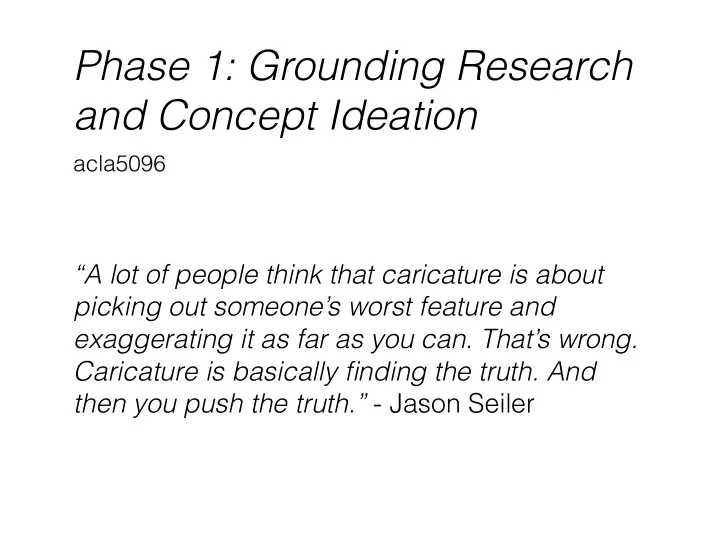

Phase 1: Grounding Research and Concept Ideation acla5096 “A lot of people think that caricature is about picking out someone’s worst feature and exaggerating it as far as you can. That’s wrong. Caricature is basically finding the truth. And then you push the truth.” - Jason Seiler
The Caricature Derived from the Italian word caricare - to charge or load Meaning: a loaded portrait Caricature can be symbolic or pictorial hyperbole. � They can be insulting or complimentary. Most commonly of politicians or celebrities. Ancient Pompeiian graffiti caricature of a politician The plumb-pudding in danger' (William Pitt; Napoleon Bonaparte) by James Gillray, 1805
The Caricature What makes them a success is the artist’s ability to zero in on the most distinctive aspect of somebody Filter out details to get a few defining features that are exaggerated Works better drawing off memory rather than a live model, at risk of producing a too realistic image Strong example of a creative act that is subject to preconceptions of beauty, political views, comedic purpose, motivations, stereotypes etc - inherently human characteristics
Facial Recognition Caricature is similar to the way humans encode faces and remember them - record the most defining features that allow faces to be distinguished easily Ramachandran [1] suggests the peak shift effect in which the brain favours an exaggerated concept more than a non-exaggerated version. Supported by Leopold et al.’s findings that the face-recognising neurons seem to strongly respond to the caricature version of the same faces. [1] [1] Informatics Engineering and Information Science, Part II: International Conference, ICIEIS, Part 2 of Informatics Engineering and Information Science: International Conference : Proceedings, Azizah Abd Manaf, Exploring Particle-Based Caricature Generations - Somnuk Phon-Amnuaisuk, 2011
Computer Generated Caricature 2 techniques: line drawing or image warping Process automated by variance exaggeration which exaggerates facial components that deviate from the norm , or example based generation that exaggerate components according to provided templates
Computer Generated Caricature Susan E. Brennan was the pioneer of the Caricature Generator [2] . Altered the line drawing of a face by exaggerating metric differences between the subject and prototype norm. [2] Caricature Generator: The Dynamic Exaggeration of Faces by Computer, Susan E. Brennan, Leonardo, Vol. 18, No. 3 (1985), pp. 170-178, Published by: The MIT Press
Computer Generated Caricature Akleman [3] employed a deformation based approach using morphing/warping. [3] E Aklemen, Making Caricatures with Morphing, Proceedings of the International Conference on Computer graphics and Interactive Technique ACM SIGGRAPH 1997, p 145
Computer Generated Caricature Somnuk Phon-Amnuaisuk [1] explores an interactive particle based technique that relies of user feedback to explore the caricature face space. Facial feature points are represented as particle and their movements are used to incrementally warps a given face until the desired exaggerations are achieved. [1] Informatics Engineering and Information Science, Part II: International Conference, ICIEIS, Part 2 of Informatics Engineering and Information Science: International Conference : Proceedings, Azizah Abd Manaf, Exploring Particle-Based Caricature Generations - Somnuk Phon-Amnuaisuk, 2011
Idea Generation • What would happen if a robot was asked to create a caricature? • How would you create a caricature free from human preconceptions, prejudices, stereotypes, political views, beauty ideals? Could these be intrinsically human things be replicated in code? � • Exploration of how we see ourselves/each other by removing societal preconceptions • Exploration of how a robot would identify distinguishing features for facial recognition • Applications in facial recognition? Aid in learning faces? Identifying facial expressions and their corresponding emotions?
Concept 1 - Comparative Caricature An exploration of how robots see us and distinguish us from one another. � Interaction Scenario: 1. Two people enter view of camera and have portrait taken 2. Robot identifies facial features, creates norm “average” or morph of 2 faces 3. Analyses differences between each face and selects features to emphasise 4. Robot draws portrait of each user with distorted features 5. User repeats process with another partner and compare the caricatures generated
Concept 1 - Comparative Caricature 1. Two people enter view of camera and have portrait taken 2. 2D image is created for comparison of 2 faces 3. Facial features are mapped as points. Distances and 4. Caricature is drawn by distorting facial features sizes of features are calculated and most significant (placement of eyes, size of nose, width of mouth etc) differences are selected for exaggeration. Thick felt tipped pen used to achieve stylised effect.
Concept 2 - Deviation from Norm An exploration of how a human and robot can collaborate to create a caricature. � Interaction Scenario 1. ‘Norm’ face is calculated from average of large sample of portrait images 2. Image of user’s face is captured by camera 3. Image is analysed to calculate metrics of facial features, and how much they deviate from the ‘norm’ 4. User is presented with several variations of distortion (different facial features’ deviations chosen to be exaggerated e.g. size, placement, symmetry) 5. User selects favourite variation to proceed 6. Robot continues to exaggerate or distort this selected feature and present user with iterative variations 7. Selection process is repeated until user is happy with resulting distortion 8. Robot draws this image as a stylised caricature
Concept 2 - Deviation from Norm 1. User sits down in a typical live model caricature setting. 2. Image is analysed to calculate metrics of facial features, Camera takes image of user’s face. and how much they deviate from the ‘norm’ 3. User is presented with a set of on-screen variations each 4. After several iterations user can select that they are exaggerating a different facial feature. User selects their happy with a final variation and the robot draws this as a favourite distortion to proceed. stylised caricature
Recommend
More recommend